Healthcare-NOW’s Grassroots Legislative Advocacy Training
Healthcare-NOW’s Grassroots Legislative Advocacy Training
Grassroots organizations rarely have the kinds of power, such as money or influence, that can be exercised behind closed doors. This training will teach you how to exercise the type of power you do have to take public actions to move your legislators.
Moving a resistant legislator with grassroots muscle requires mobilizing a network of community activists and/or a coalition of organizations with grassroots bases, a strategy rooted in an analysis of power, and a plan to execute escalating tactics that will end in taking public actions.
In order to be effective, these actions must take advantage of the power you have built through community organization and coalition-building.
- Step #1: Score Your Legislators’ Level of Support
- Step #2: Choose One Priority Target & Make a Power Map
- Step #3: Develop a Campaign of Escalating Grassroots Tactics to Move Your Legislator
Step #1: Score Your Legislators’ Level of Support
First you’re going to get the lay of the land – who are your legislators, and where do they stand on the issue of single payer healthcare? You’ll end up choosing one legislator – your priority target – who will be the focus of the rest of this campaign.
The first step is to develop a scoring system for your legislative delegation. Scores will range from hostility all the way up to leadership. Not only should your score be based on your legislator’s existing stance on the issue, but the score must be based on a measurable act you can ask your legislator to do.
For example, if your legislator is hostile and has publicly stated they won’t support single payer, you’ll try to move them to a neutral position; if they’re in a neutral position, you’ll try to move them to cosponsorship or other supportive measures; if they’re already a cosponsor, you’ll invite them to become an outspoken leader.
It helps if there’s a measurable stepping stone between neutrality and co-sponsorship of a bill (such as supporting intermediate legislation, or voting on an amendment) – but again, it must be an act you can ask the legislator to do.
Step 1: Download the Legislative Scoring System Worksheet here. If you’re working on H.R. 676 or the Senate bill, you may find it easiest to use the sample score that have been provided:
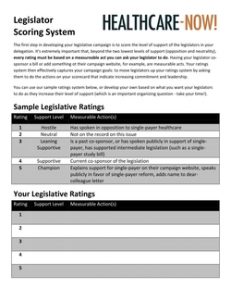
Step 2: When you have settled on a scoring system (or decided to use ours), the next step is to score your legislative delegation and make some notes about your and your activists’ interactions with them.
Don’t forget about legislators after they have signed onto your bill: have a clear pathway for supportive legislators to take on greater leadership to help the movement.
Download a Blank Legislative Score Card here:
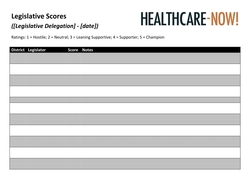
See an example Legislative Score Card from Massachusetts:
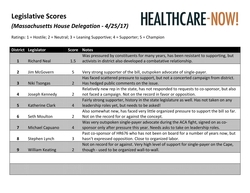
Step #2: Choose One Priority Target & Make a Power Map
Now that you’ve scored all your legislators, choose a target. If you’re just organizing a district and have only one rep, this might be easy. If you’re coordinating a state campaign, you’ll need to do a separate power map for each legislator/target. Go for the easiest targets first.
The next step is to map the power relationships between you and your legislator, which will be the basis for developing a campaign to increase your leverage and use the power you build to move your legislator. The power map will help you decide which potential allies to bring on board your campaign.
Download a Blank Power Map here:
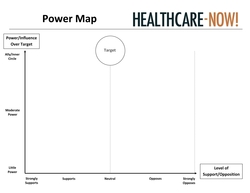
A power map is an old organizing tool: fill in your target’s name (the legislator) at the top in the middle, then place all organizations and individuals on the map who might exercise (or already have exercised) influence over the legislator on this issue. The greater the power/influence they have over this particular legislator on this particular issue, the higher (vertically) you place them on the map; the more supportive of your issue they are, the further to the left you place them – and the more hostile they are, the further to the right (horizontally).
Start with your group and your closest allies, and work your way out to individuals and organizations who are occasional or potential allies. Then work out from your legislator, mapping their relationships that are relevant to this issue – including donors; any groups the legislator has been linked to that might care about healthcare; and any key political institutions or individuals in their district. Finally, make sure to include the opposition: all the groups and individuals likely to oppose your bill, and how close they are to the legislator on this issue.
Download an example Power Map (from the Massachusetts Case Study):
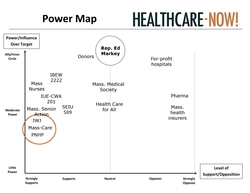
Step #3: Develop a Campaign of Escalating Grassroots Tactics to Move Your Legislator
If your coalition has enough power to move the legislator when fully activated then it’s time to develop a campaign of escalating tactics that you have the resources and staff/volunteer time to carry out. Continue Step #3!
If your coalition will not have enough power to move the legislator when fully activated, you are looking at a longer-term campaign in which you and your allies will first want to win the support of intermediate targets, who do have the power to move your legislator (and you’ll have to make a separate power map to move them!). Go back to Step #2.
Download the Campaign Planning Worksheet:
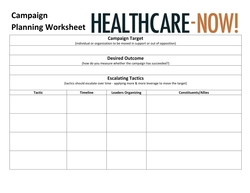
Moving to public action as part of a legislative strategy is challenging because it is resource intensive, and many organizations don’t have the capacity to execute the more resource-intensive tactics in more than a few districts at a time. It is also challenging because it can involve applying public pressure to an official you wish to become an ally – elected officials do not like being organized against, so activists need to be extraordinarily careful to maintain cordial private and public messaging, even while escalating their tactics and using the grassroots power they have. Because of this, it’s ideal to include long-time supporters of the legislator in the coalition, and to avoid developing an oppositional relationship, which will guarantee failure.
Here are some guidelines for choosing the tactics that will make up your campaign:
- Tactics should always start with minimal effort and private actions (e.g. calls, emails, in-person meetings), then escalate to public actions that are more resource-intensive, but take advantage of the power you have in that legislator’s district. The goal is to make the most of the resources you have, and to offer legislators ample time to get to know your activists (if they don’t already), to express any legitimate reservations, and do the right thing on their own.
- Public actions must maintain a respectful – ideally supportive – tone towards the legislator you are trying to move, or you risk alienating them and establishing an oppositional relationship. If door-knocking, leafleting in their district, or speaking with media, it’s more effective to say that the legislator has been a leader on other issues and you are asking for his/her leadership on this issue, than it is to attack or criticize them for example.
- When trying to move legislators who are hostile to your cause or neutral, actions that impose political costs are more likely to be appropriate. When trying to move legislators who are supportive into higher levels of commitment and leadership, actions that offer political rewards are more likely to be appropriate. Creating political incentives could involve inviting a supportive legislator to speak at events that put them in front of potential supporters, for example.
- Tactics should vary depending on the district, the time of year, the election cycle, and the legislative cycle. Bird-dogging, for example, could be an effective tactic leading up to elections, as could town hall meetings when the legislature is out of session. Phone banking would be a poor tactic when the legislature is not in session.
Case Study: Winning Support from Ed Markey in Massachusetts
Between 2006 and 2009, a coalition of individuals, unions, and community organizations in Massachusetts ran a successful multi-year campaign to win the support of Representative Ed Markey (who is now a Senator) for HR 676, the Expanded & Improved Medicare for All Act.
Legislative Score: Rep. Markey scored “Leaning Supportive,” as he was a former co-sponsor of single-payer legislation submitted by Paul Wellstone, and because he had privately expressed support for the concept of single-payer healthcare reform. The goal of the campaign was to move Rep. Markey to become a “Supporter” by co-sponsoring HR676, which he had resisted doing.
Power Map: The campaign was led by Mass-Care and Jobs with Justice, and a power map of the district shows that a number of allied unions and community organizations had strong membership bases in Rep. Markey’s district and, in a couple of cases, good relationships with Rep. Markey.
Download the Power Map from the Massachusetts Case Study:

Campaign Plan and Outcomes: Mass-Care and Jobs with Justice reached out to the unions and organizations identified on the power map and developed a campaign of escalating tactics.
Download the Campaign Plan from the Massachusetts Case Study:
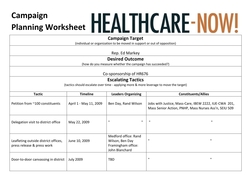
- The first tactic was to submit a petition to Rep. Markey from constituents on May 11, 2009, and ask for a district office meeting by May 22 (which was scheduled for May 20). Following the meeting, a press release and photos of the meeting were sent to local media, describing the meeting and promising further actions to come – it was titled: “Seventh District health care reformers vow stepped-up campaign to convince Rep. Ed Markey to co-sponsor HR 676, the national Medicare for All bill.” Rep. Markey wrote a letter in response to the meeting stating that he still had reservations about the bill, and would not be co-sponsoring it.
- An image of activists meeting with Rep. Markey’s district staff:

- Download a copy of the petition as a pdf or as a Word doc here.)
- Download a copy of the press release as a pdf or as a Word doc here.
- Download Rep. Markey’s reply to activists, stating that he will not co-sponsor HR676.
- An image of activists meeting with Rep. Markey’s district staff:
- The second tactic, if Rep. Markey had not yet signed onto HR676, was to leaflet outside both of his district offices in Medford and Framingham on June 10, 2009, and ask his constituents to call his office. A press release was sent to local media, and a local newspaper in the district put the action on their front page that week.
- An image of activists leafleting outside of Markey’s Medford district office:

- Download a copy of the press release sent to local media as a pdf or as a Word file here.
- An image of activists leafleting outside of Markey’s Medford district office:
- The third tactic, if Rep. Markey did not respond to public leafleting and press coverage, was to launch a longer-term door-knocking campaign in his district starting in July. However, immediately after the June 10 actions outside his offices, Rep. Markey agreed to co-sponsor HR676, and subsequently became a fairly strong advocate for single-payer healthcare! A press release was sent to local media announcing victory, and thanking Rep. Markey for his support.
- Download the press release as a pdf or as a Word file here.
Organizing Your District Office Visit
Plan Your District Office Visit: Lead Contact, Pushback Training for Delegation, Designated Story Tellers
